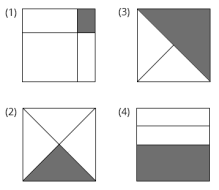Fractions
In this article, the learning objectives are:
- What is Fractions?
- Understanding the simplest form: Practice Problems
- Finding equivalent fractions: Practice Problems
What is Fractions?
Fraction is used to represent part of a whole in mathematics. It's a quotient where the numerator at the top, is divided by the denominator, by the bottom number, to define the fractional part. Fractions are essential for expressing parts, ratios, and proportions in various mathematical and real-world contexts.
For example, the circle shown is divided into 3 equal parts.
1 out of 3 parts is shaded.
\(\frac {1}{3}\) of the figure is shaded.
Watch Our Video Lesson!
Practice Problems
Question 1:
What fraction of the figure is shaded?
- \(\displaystyle{\frac {1} {2}}\)
- \(\displaystyle{\frac {1} {3}}\)
- \(\displaystyle{\frac {1} {4}}\)
- \(\displaystyle{\frac {1} {5}}\)
Solution:
The circle is divided into \(\displaystyle{4}\) equal parts.
\(1\) out of \(4\) parts are shaded.
\(\displaystyle{\frac {1} {4}}\) of the figure is shaded.
Answer:
(3) \(\displaystyle{\frac {1} {4}}\)
Question 2:
What fraction of the figure is shaded?
- \(\displaystyle{\frac {1} {6}}\)
- \(\displaystyle{\frac {2} {6}}\)
- \(\displaystyle{\frac {4} {6}}\)
- \(\displaystyle{\frac {5} {6}}\)
Solution:
The circle is divided into \(6\) equal parts.
\(4\) out of \(6\) parts are shaded.
\(\displaystyle{\frac {4} {6}}\) of the figure is shaded.
Answer:
(3) \(\displaystyle{\frac {4} {6}}\)
Question 3:
What fraction of the figure is not shaded?
- \(\displaystyle{\frac {1} {8}}\)
- \(\displaystyle{\frac {3} {8}}\)
- \(\displaystyle{\frac {5} {8}}\)
- \(\displaystyle{\frac {7} {8}}\)
Solution:
The circle is divided into \(8\) parts.
\(3\) out of \(8\) parts are not shaded.
\(\displaystyle{\frac {3} {8}}\) of the figure is not shaded.
Answer:
(2) \(\displaystyle{\frac {3} {8}}\)
1. Understanding The Simplest Form
A fraction is in its simplest form if the numerator and the denominator cannot be divided by the same number any further.
|
Circle A |
Circle B |
Circle C |
Practice Problems
Question 1:
Express \(\displaystyle{\frac {6} {24}}\) in its simplest form.
Solution:
OR
Answer:
\(\displaystyle{\frac {1} {4}}\)
Question 2:
Express \(\displaystyle{\frac {5} {15}}\) in its simplest form.
Solution:
Answer:
\(\displaystyle{\frac {1} {3}}\)
Question 3:
Express \(\displaystyle{\frac {3} {18}}\) in its simplest form.
Solution:
Answer:
\(\displaystyle{\frac {1} {6}}\)
Question 4:
Express \(\displaystyle{\frac {6} {10}}\) in its simplest form.
Solution:
Answer:
\(\displaystyle{\frac {3} {5}}\)
Question 5:
Express \(\displaystyle{\frac {12} {15}}\) in its simplest form.
Solution:
Answer:
\(\displaystyle{\frac {4} {5}}\)
Question 6:
Express \(\displaystyle{\frac {8} {20}}\) in its simplest form.
Solution:
Answer:
\(\displaystyle{\frac {2} {5}}\)
2. Finding Equivalent Fractions
Equivalent fractions are fractions with different numerators and denominators but they represent the same value or proportion of a whole.
| Circle A | Circle B |
| \(\displaystyle{\frac {1} {3}}\) | \(\displaystyle{\frac {2} {6}}\) |
The areas shaded in both circles are exactly the same.
Hence, \(\frac{1}{3}\) and \(\frac{2}{6} \) are equivalent fractions.
| \(\frac {\; 1 \;} {\; 2 \;}\) | \(\frac {\; 2 \;} {\; 4 \;}\) | \(\frac {\; 4 \;} {\; 8 \;}\) |
Equivalent fractions when expressed in their simplest form are the same.
Practice Problems
Question 1:
What is the missing number?
\(\displaystyle{\frac {4} {10}=\frac {2}{?}}\)
Solution:
The missing number is 5.
Answer:
5
Question 2:
What is the missing number?
\(\displaystyle{\frac {9} {12} = \frac{3}{?}}\)
Solution:
The missing number is 4.
Answer:
4
Question 3:
What is the missing number?
\(\displaystyle{\frac {12} {18}=\frac{4}{?}}\)
Solution:
The missing number is 6.
Answer:
6
Question 4:
What is the missing number?
\(\displaystyle{\frac {3} {5}=\frac{?}{10}}\)
Solution:
The missing number is 6.
Answer:
6
Question 5:
What is the missing number?
\(\displaystyle{\frac {3} {4}=\frac{?}{12}}\)
Solution:
The missing number is 9.
Answer:
9
Question 6:
What is the missing number?
\(\displaystyle{\frac {2}{3}=\frac{?}{18}}\)
Solution:
The missing number is 12.
Answer:
12
Question 7:
Which of the following is equivalent to \(\displaystyle{\frac {\; 3 \;} {\; 4 \;}}\)?
- \(\displaystyle{\frac {4}{8}}\)
- \(\displaystyle{\frac {8} {12}}\)
- \(\displaystyle{\frac {13} {16}}\)
- \(\displaystyle{\frac {15} {20}}\)
Solution:
Answer:
(4) \(\displaystyle{\frac {15} {20}}\)
Question 8:
Which of the following is equivalent to \(\frac {\; 2 \;} {\; 12 \;}\)?
- \(\frac {\; 1 \;} {\; 6 \;}\)
- \(\frac {\; 2 \;} {\; 6 \;}\)
- \(\frac {\; 3 \;} {\; 6 \;}\)
- \(\frac {\; 4 \;} {\; 6 \;}\)
Solution:
Answer:
(1) \(\frac {\; 1 \;} {\; 6 \;}\)
Question 9:
Which of the following is equivalent to \(\frac {\; 4 \;} {\; 6 \;}\)?
- \(\frac {\; 1 \;} {\; 3 \;}\)
- \(\frac {\; 3 \;} {\; 7 \;}\)
- \(\frac {\; 8 \;} {\; 12 \;}\)
- \(\frac {\; 14 \;} {\; 16 \;}\)
Solution:
Answer:
(3) \(\frac {\; 8 \;} {\; 12 \;}\)
Test Yourself
4 / 5 - 8 / 20 =
Ans: (A) 2 / 5
Which of the following is not an equivalent fraction of 6 / 9?
Ans: (B) 3 / 4
Which diagram below shows 1 / 4 of the figure is shaded?

Ans: (B) Figure 2
Is there any fraction between 6 / 8 and 7 / 8? If yes, which of the following is one of them?
Ans: (C) 13 / 16
Find the sum of 1 / 3 and 7 / 12.
Ans: (D) 11 / 12




 SG
SG  VN
VN 
















